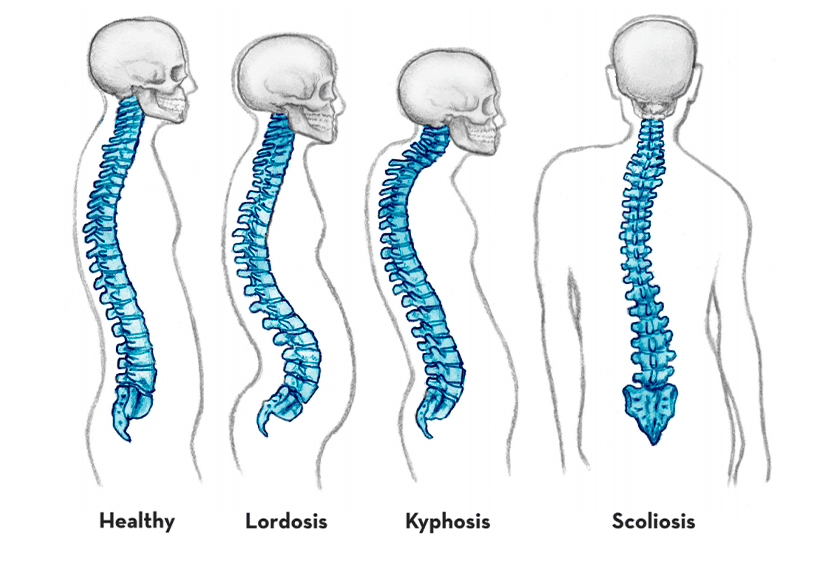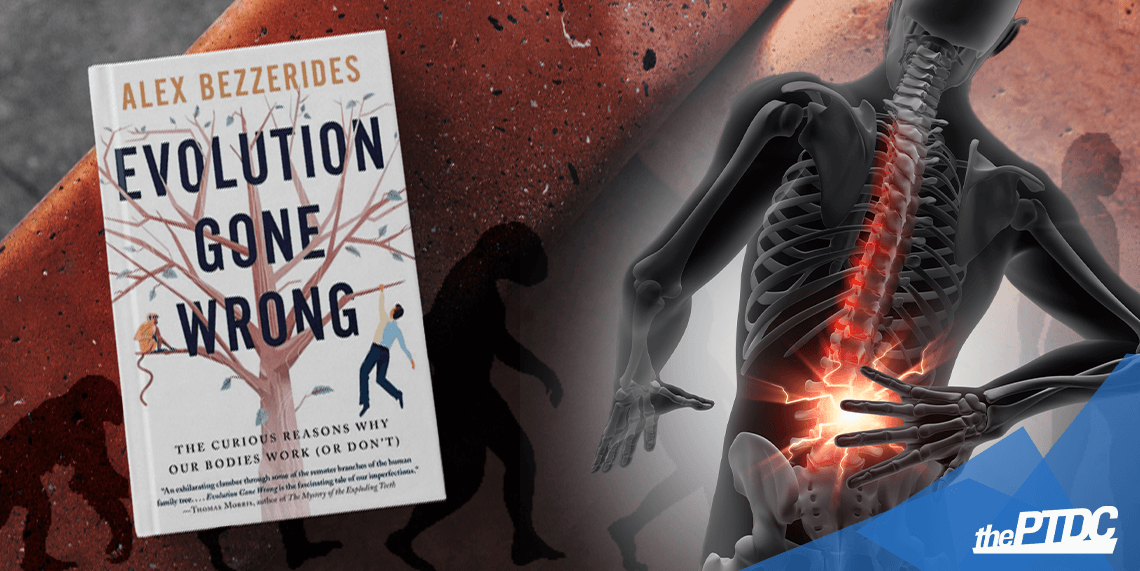This following is an excerpt from Evolution Gone Wrong, by Alex Bezzerides, republished here with permission.
Back pain is a universal conundrum for which we do not have a good solution.
Conveniently for me, I’m not here to talk about solutions.
I’m here to talk about why, as humans, we are uniquely prone to back pain.
A Gates Foundation-funded study reported low-back pain as the leading cause of global disability.
Other leading causes were:
- major depressive disorders,
- iron-deficiency anemia,
- and neck pain (really just high-back pain, radiating out from the cervical portion of the spinal column instead of the lumbar portion of the spine).
The back is going to get you one way or the other, be it high, low, or somewhere in between.
The shape is the issue.
The shape is the short story behind back pain.
The center of gravity of the body had to shift in order for a quadruped to balance itself on two feet.
For example, a chimpanzee’s vertebral column is C-shaped, placing the center of gravity well forward of the hips.
If chimps force themselves onto two feet, it takes a lot of muscular effort to overcome their natural forward pitch.
So chimps typically avoid walking around bipedally. They tend to walk on all fours, saving the strain on their backs.
Real quick: Let’s talk about how humans may have evolved to walk on two feet instead of four:
Like chimps, human babies are born with C-shaped spines. It makes sense, therefore, that human babies are not born bipedal.
As babies get bigger and stronger, their vertebral columns start to develop the other curves that switch their spines from rigid, horizontal beams to more flexible, vertical structures.
Early in life, the muscles and curves are developing but not yet strong enough to hold babies upright.
During this period, babies get around by crawling.
Once the curves develop and the muscles are strong enough, then they are off and toddling.

In the transitional period, you can almost picture kids deciding if it's worth the effort to walk to the other side of the room or if they should just crawl.
The first steps can happen as early as six months and as late as 18 months, but somewhere around one year is typical.
I was at a party recently where a toddler did something I had never seen before.
She had just learned to walk and was in that stage where there is a lot of wobbling and stumbling.
At one point she tipped over and instead of going all the way down to crawling, she caught herself on her hands and proceeded to make her way across the entire living room floor on all fours.
It was fascinating to watch and felt for a second like I had stepped back in time a few million years.
Maybe when she grows up, she’ll break the record for the fastest 100 meters running on all fours.
What happens when curves develop
The lower lumbar curve shifts the center of gravity back, placing it above and slightly behind the hips.
This change in the center of gravity allows toddlers to toddle and adult humans to stand all day and not fatigue.
The higher-up cervical curvature allows us to balance our large heads on top of our spines without constant contraction of the neck muscles.
Clearly, there are advantages to the change in the shape of the human spine.
I, for one, like walking around on two feet. You get a better view of the world, and I enjoy having my hands free at all times.
There are, however, some significant cons to go with those pros. The shape of the curves has to be just right or everything goes haywire.
Think of the vertebral column as a series of children’s blocks.
In other mammals, the blocks are lined up horizontally, as if they are laid down on a table. You could not knock them over because they are just sitting there.
In a human, the blocks are upright, like a tower.
Even before introducing curves, the structure is much more precarious. Now, as one final twist, next time you construct a block tower, try building a few curves into it and see how that goes for you.
The angle and degree of spacing between the vertebrae are critical.
If the spacing between the vertebrae is not right, the intervertebral discs can go oozing out of place. It is a very delicate area for anything to be out of place because the spinal cord runs like a highway right through the middle of it all.
At each exit on the highway, nerve roots branch off the spinal cord. Pain begins as soon as a disc bulges out of place and contacts a nerve.
The pinching can happen acutely when you bend over to pick something up, or it can happen chronically when the spine does not end up with the right amount of curvature.
The inward, or lordotic, lumbar curve needs to be far enough inward to place the position of the spine under the head and to get the center of gravity above the hips.
Sometimes there is too much lordotic lumbar curvature.
In a confusing bit of terminology, the natural curve is called lordosis and the condition where the curve arches too much is called . . . lordosis (or swayback).
Too little lordosis = back pain.
Too much lordosis = back pain.
The right amount of lordosis = total bliss.*
*At least until you’re old, when there will likely be some back pain no matter how perfect your curves are.
Even the more ancestral curve through the middle, or thoracic, portion of the back (the one present at birth responsible for the C-shaped spine of babies) can get out of whack.
Kyphosis is an excessive outward curvature, and when taken to the extreme it can cause an individual to appear hunchbacked.
As the bones and muscles of the back weaken, the spine can become kyphotic, causing some elderly people to look as if they are on the verge of falling forward.

Schoolkids are often evaluated for scoliosis, a different type of abnormal curvature.
Lordotic and kyphotic curves are visible only when the spine is viewed from the side.
In scoliosis, the spine curves sideways, making it possible to see the condition when viewed from behind.
Children are checked during elementary school because it is important to catch the problem early.
Many scoliosis cases require only consistent monitoring rather than intervention, but in more serious circumstances, a child may need to wear a brace or even undergo surgery.
The condition is considered idiopathic (meaning we do not know what causes it), but it certainly cannot have helped when our ancestors left our stiff, beam-like spine up in the trees and traded it out for a fancy, flexible, curvy model.
How pregnancy impacts the back
There is an added challenge for the spine in roughly half the population: the possibility of bearing children.
For all the quadrupeds out there, from dogs to armadillos to gorillas, being pregnant does not have much of an effect on the center of mass.
There is definitely additional mass for a pregnant quadruped, but the extra weight hangs down in virtually the same direction the weight was going prior to pregnancy.
The story is markedly different for a human female.
Carrying unborn children in the front is a significant challenge.
All men should have to carry a watermelon under their shirts for several months to get some idea of what a literal pain it is. Even the watermelon challenge is not a fair comparison, because unless you had it surgically implanted, there is no way to get it shoved right up against the bladder. Also, watermelons don’t kick.
Being pregnant greatly shifts the center of mass of a woman’s body forward.
The center of mass needs to have a way of shifting back.
Otherwise, as discussed in an article in the journal Evolution and Human Behavior, “ancestral women would have been subjected to a nearly 800% increase in hip torque during pregnancy.”
It’s hard to believe it could be worse than it is, but an 800 percent increase in hip torque would translate to an even greater degree of muscle strain and back pain than is already present during those joyful nine months.
More lumbar lordosis is the key. All humans naturally possess lumbar lordosis, but when women become pregnant, they become uberlordotic.
The extreme shift in the shape of the spine during pregnancy pushes the center of gravity back, but it also causes extensive shearing forces (where parts of the body are pulled in opposite directions) throughout the lower back.
Those shearing forces are at the root of the intense and persistent back pain experienced by many women during pregnancy.
The best-case scenario is sciatica and a sore lower back. The worst-case scenario is a herniated disc. During the years after hominins became bipedal, there would have been strong selective forces for anatomical varieties that reduced the degree of shearing and pain.
Women with bodies more able to cope with a bipedal pregnancy would have been able to forage to a greater degree and provide better care for their growing families.
The shape of men’s and women’s lumbar vertebrae reveals the strong selective pressure on the back.
In both sexes, the penultimate and last lumbar vertebrae are wedge shaped, which helps the spine disperse the pressure placed on the lower back.
In females, the lordotic lumbar wedging reaches up to include an additional vertebra.
It might not seem like much, but the difference is significant.
Having one more wedge-shaped vertebra allows females to mitigate the effects of shearing and stress caused by the extreme degree of lordotic curvature assumed during pregnancy.
What you can do about back pain (spoiler: not much)
More than any other issue, the back is going to get you.
If you are unlucky, the pain starts in your teens or 20s, maybe in relation to an athletic endeavor or some act of youthful hubris. More typically, the pain will hold off until your 30s or 40s.
If you are incredibly fortunate, it may not even kick in until after 50. But it is coming. There is no avoiding it.
The weight of your body squashes those discs every day, and there’s not a damn thing you can do about it.
You can lose weight, strengthen your core, and not help your friends move their sleeper sofa, but eventually the checkered evolutionary past of humans is going to catch up to you.
At the end of the day, you’re a bipedal beast walking around with largely quadrupedal parts.

Sorry. Schedule a massage, take a hot shower, and try to remember the great benefit that hopefully offsets the cost of the pain—your hands are free to do whatever you want.
All those other critters may not suffer from as much back pain as humans, but they are also stuck scrabbling around on all fours.
I do think we got the better end of the bargain, but I also don’t suffer from excessive back pain. If I ever have a herniated disc, you can bet I’ll be cursing the bipedal life all the way to the doctor.











